Jalgaon
- | |
|---|---|
City | |
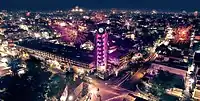 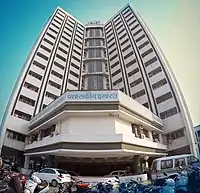 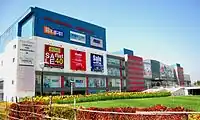 Clockwise- Jalgaon's skyline, Khandesh Central mall, Municipal council building | |
| Nickname: Banana city | |
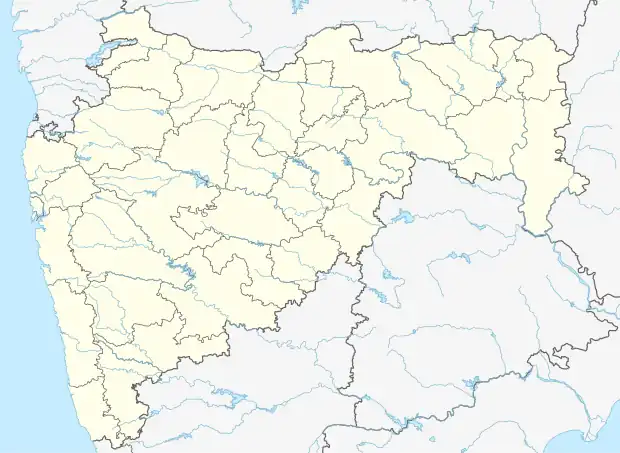 Jalgaon Jalgaon in Maharashtra,India  Jalgaon Jalgaon (India) .svg.png.webp) Jalgaon Jalgaon (Earth) | |
| Coordinates: 21°00′14″N 75°34′05″E / 21.004°N 75.568°E | |
| Country | |
| State | Maharashtra |
| Region | Khandesh |
| District | Jalgaon |
| Government | |
| • Type | Municipal corporation |
| • Body | Jalgaon Municipal Corporation |
| • Mayor | Jayshree Mahajan(Shivsena) |
| Area | |
| • Total | 98 km2 (38 sq mi) |
| [1] | |
| Dimensions | |
| • Length | 17.4 km (10.8 mi) |
| • Width | 14.3 km (8.9 mi) |
| Elevation | 216 m (709 ft) |
| Population (2011)[2] | |
| • Total | 650,000 |
| • Rank | India: 93rd Maharashtra: 13th |
| • Density | 6,600/km2 (17,000/sq mi) |
| Demonym | Jalgaonkar |
| Language | |
| • Official | Marathi |
| • Spoken | Khandeshi (Ahirani)[3] |
| Time zone | UTC+5:30 (IST) |
| Telephone code | 0257 |
| Vehicle registration | MH-19 |
| Literacy Rate | 77.22% |
| Website | www |
Jalgaon (ⓘ) is a city in Maharashtra, India. The city is located in North Maharashtra in the subregion of Khandesh, and serves as the administrative headquarters of its namesake district, the Jalgaon district. The Girna river flows from the western part of the city. Jalgaon is colloquially known as the "Banana city of India" as the region's (Jalgaon district) farmers grow approximately two-thirds of Maharashtra's banana production.[4]
According to Abul Fazal (Gladwin's AineAkbari 1157), the name Khandesh is derived from the "Khan" title given by Ahmad-I of Gujarat (1411-1443) to Malik Nasir, the second of the Faruki kings. According to some sources, the name comes from the Khandava forest of Mahabharat. The Mahabharat mentions Yuvanshava, the ruler of Toranmal (Nandurbar district) as fighting with the Pandavas. The rock temples and caves at Nashik and Ajanta show that during the first three centuries AD, Khandesh was under the rulers who patronized Buddhism. Thereafter, it was ruled by Saptavananas, Andhrabhrityas, Virsen (Ahir King), Yawan dynasty, Chalukyas, Yadavs and then Alaud-din Khilji, Mohammad Tughlak, Malik Raja Malik Nazir, the Nizam of Hyderabad, and subsequently the Marathas ruled the region.
The former Khandesh which was controlled by the Faruqui dynasty of Burhanpur, was than well established by the Maratha Royal named Tulajirao Bhoite and became Jalgaon. The Bhoite rulers built a mansion there which is now recognized as Bhoite Gadhi. In the 18th century, Khandesh was captured by British troops from the Holkar regime with Dhule as the headquarters. Robert Gill was the first officer of British East India Company in the Khandesh District with headquarters in Dhule.In 1906 Khandesh was divided between East Khandesh and West Khandesh, and Jalgaon became the headquarters of East Khandesh district.[5] After the 1956 reorganisation of India's states, East Khandesh became part of Bombay State and later in 1960 it became part of Maharashtra.[6]
Transport
Jalgaon's airport was built in 1973 by the Public Works Department.[7] The Jalgaon municipal council took over its operations in April 1997 and handed it over to the Maharashtra Airport Development Company in April 2007.[8] The Government of Maharashtra signed a Memorandum of Understanding (MoU) with The Airports Authority of India (AAI) to upgrade the existing airfield in July 2009.[9] Pratibha Patil, then president of India, laid the foundation stone for the development and expansion of the Jalgaon airport in June 2010.[10] Jalgaon offers flights to Mumbai, Hyderabad, Ahmedabad, Kolhapur, Nashik and Nanded operated by Trujet airlines.[11]
The city is served by the Jalgaon Junction railway station. The railway connects the city to major cities like New Delhi, Mumbai, Hyderabad, Kolkata, Panvel, Chennai, Agra, and Lucknow.[12]
Education
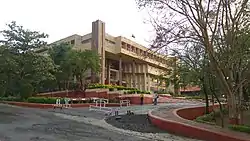
North Maharashtra University is located 8 km away from thecity's center. Prominent under/post-graduate colleges in thecity are Mooljee Jetha College and Nutan Maratha College.
Jalgaon has two medical colleges, Government Medical College and Dr. Ulhas Patil Medical College and Hospital, Jalgaon.[13] and the Government Ayurved College, Jalgaon providing the knowledge of Ayurveda. [14]
Climate
Jalgaon has a hot semi-arid climate (Köppen BSh) owing to the rain shadow of the Western Ghats. There are three seasons in Jalgaon: the sweltering and arid "hot" season from March to mid-June, the hot and steamy "wet" under the monsoon from mid-June to September, and the hot and dry "cool" season from October to February. In Jalgaon District, the average annual rainfall is around 690 mm and the temperature can range from 10 to 48 degrees Celsius, making it a diverse climate with scorching summers of up to 45 degrees Celsius.[15]
| Climate data for Jalgaon City (1981-2010, extremes 1969-2008) | |||||||||||||
|---|---|---|---|---|---|---|---|---|---|---|---|---|---|
| Month | Jan | Feb | Mar | Apr | May | Jun | Jul | Aug | Sep | Oct | Nov | Dec | Year |
| Record high °C (°F) | 35.9 (96.6) |
41.2 (106.2) |
43.9 (111.0) |
47.2 (117.0) |
48.4 (119.1) |
46.6 (115.9) |
43.9 (111.0) |
40.4 (104.7) |
39.8 (103.6) |
39.5 (103.1) |
37.7 (99.9) |
36.4 (97.5) |
48.4 (119.1) |
| Mean daily maximum °C (°F) | 30.3 (86.5) |
32.8 (91.0) |
37.6 (99.7) |
41.2 (106.2) |
42.4 (108.3) |
38.0 (100.4) |
32.8 (91.0) |
30.8 (87.4) |
32.8 (91.0) |
34.5 (94.1) |
32.7 (90.9) |
30.4 (86.7) |
34.7 (94.5) |
| Mean daily minimum °C (°F) | 12.2 (54.0) |
13.9 (57.0) |
18.6 (65.5) |
23.9 (75.0) |
26.9 (80.4) |
25.9 (78.6) |
24.3 (75.7) |
23.5 (74.3) |
23.1 (73.6) |
19.4 (66.9) |
14.8 (58.6) |
11.9 (53.4) |
19.9 (67.8) |
| Record low °C (°F) | 1.7 (35.1) |
3.9 (39.0) |
8.2 (46.8) |
13.1 (55.6) |
19.0 (66.2) |
19.3 (66.7) |
18.8 (65.8) |
17.1 (62.8) |
12.3 (54.1) |
9.5 (49.1) |
5.0 (41.0) |
1.7 (35.1) |
1.7 (35.1) |
| Average rainfall mm (inches) | 4.2 (0.17) |
1.6 (0.06) |
4.5 (0.18) |
2.6 (0.10) |
10.8 (0.43) |
145.5 (5.73) |
207.0 (8.15) |
195.0 (7.68) |
116.2 (4.57) |
45.5 (1.79) |
11.3 (0.44) |
2.4 (0.09) |
746.5 (29.39) |
| Average rainy days | 0.3 | 0.3 | 0.4 | 0.3 | 0.9 | 6.9 | 12.3 | 10.9 | 6.6 | 2.7 | 0.6 | 0.3 | 42.5 |
| Average relative humidity (%) (at 17:30 IST) | 40 | 33 | 25 | 21 | 25 | 47 | 67 | 74 | 62 | 43 | 38 | 41 | 43 |
| Source 1: India Meteorological Department[16][17] | |||||||||||||
| Source 2: Government of Maharashtra[18] | |||||||||||||
Tourist attractions
Gandhi Teerth is one of the biggest tourist attractions in Jalgaoncity. It is a research institution and museum based on the life of Mahatma Gandhi. It was established on 25 March 2012 by the Gandhi Research Foundation.[19]
Guru Purnima festival at Maharishi Krishna Dvaipayana Vedvysa Temple in Yawal is also a popular pilgrimage destination. It is visited by pilgrims from within Jalgaon and neighboring states like Madhya Pradesh. The temple is located at the confluence of the river Hadkhai-Khadkai also known previously as River Harita and Sarita. Vyasa was invited by the sage Lomasha to perform a sacrifice for the Pandavas after their incognito exile. It is one of the main three temples of Vyasa, the others being Vyas Chatti, Badrinath and Vyas Kashi Temple.[20]
Other ancient pilgrim places and tourist destination include,
- Changdeva Temple
- Patnadevi, an old temple built by the Mandlik kings of Yadav completed in year 1128 AD.
- Mudhai Devi Temple, of Hemadpanti architecture built around 1150–1200 AD
- Saint Muktabai Temple, home to Muktabai Dindi, which has been an integral part of the Pandharpur Wari for over 310 years.[21]
- Satpuda Manudevi Temple, Adgaon
- Unapdev Hot Water Fountain was mentioned in the Ramayana epic and has a touch of Lord Rama during his fourteen-year exile from Ayodhya[22]
- Padmalaya – Ganpati Temple (Prabhakshetra), is one of the Saade-teen (three and a half) 'Shree Ganapati Peeth' in India. It has two swayambhu idols consist of corals and one has its trunk curving to the right and other one to the left.[23]
Demographics
As per Indian government census 2011, the population was 4,60,228 out of this 240590 were males and 219638 were females.
| Year | Male | Female | Total Population | Change | Religion (%) | |||||||
|---|---|---|---|---|---|---|---|---|---|---|---|---|
| Hindu | Muslim | Christian | Sikhs | Buddhist | Jain | Other religions and persuasions | Religion not stated | |||||
| 2001[24] | 193496 | 175122 | 368618 | – | 77.429 | 16.915 | 0.171 | 0.169 | 3.238 | 1.961 | 0.086 | 0.030 |
| 2011[25] | 240590 | 219638 | 460228 | 0.249 | 76.123 | 18.271 | 0.234 | 0.174 | 3.207 | 1.714 | 0.079 | 0.199 |
Notable people
- Bhāskara II (c. 1114–1185), aka Bhāskarāchārya, was an Indian mathematician and astronomer
- Bahinabai Chaudhari (1880–1951), a farmer whose poetry, published posthumously, helped popularize the Ahirani dialect.
- Pandurang Sadashiv Sane, aka Sane Guruji, social activist and freedom fighter worked as the teacher in Pratap High School in Amalner town.[26]
- Balkavi (1890–1918), a Marathi poet.
- Keki Moos (1912-1989), a famous artist and painter[27]
- Pratibha Patil (1934–present), a former president of India (2007–12) and governor of Rajasthan (2004–07).
- Suresh Jain, 8 times MLA from city and Ex-minister of Govt of Maharashtra.
- Ishwarlal Jain (1946 – present), three times MLA and 6 years Rajya Sabha MP. NCP Party Treasurer.
- Bhavarlal Jain (1937–2016), an entrepreneur who founded Jain Irrigation Systems.
- Ujjwal Nikam, a public prosecutor who has worked on high-profile murder and terrorism cases.
- Haribhau Jawale (1953 – present), 3 term MLA and Member of Parliament from Raver.
- Eknath Khadse (1952–present), a politician of the Nationalist Congress Party.
- Namdeo Dhondo Mahanor (1942–2023), a Marathi poet and recipient of the Padma Shri award.
- Gulab Raghunath Patil (1966–present) Senior Leader of Shiv Sena and Minister in Maharashtra.
- Suresh Damu Bhole (1965–present), MLA & President of Bharatiya Janata Party Jalgaon District.
See also
References
- ↑ "Jalgaon City Municipal Corporation". jcmc.gov.in. Retrieved 26 September 2021.
- ↑ "Where is Jalgaon, Information about Jalgaon, Where is Jalgaon, Located, Places to Visit". majorcitiesofworld.com. Retrieved 6 February 2022.
- ↑ "About District | District Jalgaon, Government of Maharashtra | India". Retrieved 20 June 2023.
- ↑ "Banana republic Jalgaon bears fruit". The Indian Express. 18 June 2004. Retrieved 3 January 2011.
- ↑ Chisholm, Hugh, ed. (1911). . Encyclopædia Britannica. Vol. 15 (11th ed.). Cambridge University Press. p. 771.
- ↑ "History | District Jalgaon, Government of Maharashtra | India". Retrieved 18 March 2022.
- ↑ "Airstrips in Maharashtra". Maharashtra Public Works Department. Retrieved 3 February 2012.
- ↑ "President inaugurates Jalgaon airport". Newstrackindia.com. 23 March 2012. Archived from the original on 7 April 2014. Retrieved 25 March 2012.
- ↑ "MADC – Projects". Maharashtra Airport Development Company. Archived from the original on 26 February 2012.
- ↑ "President lays foundation stone for Jalgaon airport". Zeenews.com. 13 June 2010. Archived from the original on 16 June 2013. Retrieved 4 February 2012.
- ↑ "Domestic airlines in India | Domestic airline tickets Booking". trujet.com. Retrieved 26 February 2022.
- ↑ "How to Reach | District Jalgaon, Government of Maharashtra | India". Retrieved 24 January 2022.
- ↑ "Government medical college & Hospital of Jalgaon". gmcjalgaon.com. 10 April 2020. Retrieved 10 April 2020.
- ↑ "Government ayurved college & Hospital of Jalgaon". gacjalgaon.com. 25 April 2023. Retrieved 25 April 2023.
- ↑ "About District | District Jalgaon, Government of Maharashtra | India". Retrieved 1 February 2023.
- ↑ "Station: Jalgaon Climatological Table 1981–2010" (PDF). Climatological Normals 1981–2010. India Meteorological Department. January 2015. pp. 347–348. Archived from the original (PDF) on 5 February 2020. Retrieved 5 April 2020.
- ↑ "Extremes of Temperature & Rainfall for Indian Stations (Up to 2012)" (PDF). India Meteorological Department. December 2016. p. M143. Archived from the original (PDF) on 5 February 2020. Retrieved 5 April 2020.
- ↑ "Climate". Government of Maharashtra. Retrieved 5 April 2020.
- ↑ "Gandhi Teerth, Jalgaon: Gandhi Tourist Places". mkgandhi.org. Retrieved 26 September 2021.
- ↑ "Programs in Yaval Vyasa Temple". Lokmat.
- ↑ "Sant Muktabai Temple". templesofindia.org. Retrieved 26 January 2022.
- ↑ "Unapdev Hot Water Fountain".
- ↑ "Shree Kshetra Padmalaya".
- ↑ Census India 2001.
- ↑ Census India 2011.
- ↑ tojsiab. "पांडुरंग सदाशिव साने इतिहास देखें अर्थ और सामग्री – hmoob.in". Retrieved 26 January 2022.
- ↑ "A forgotten genius: State ignores restoration of Keki Moos". Mumbai Mirror.



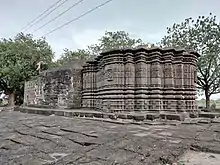
.svg.png.webp)